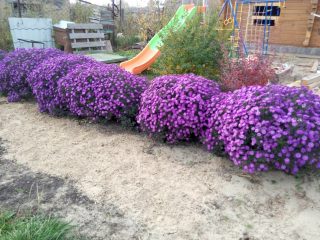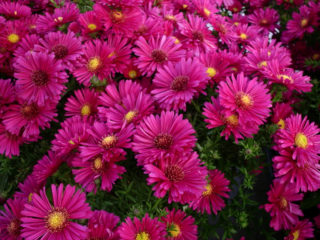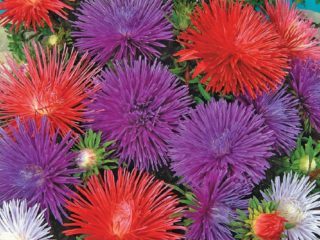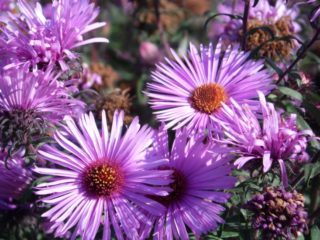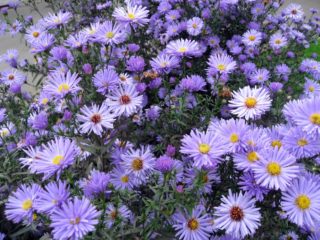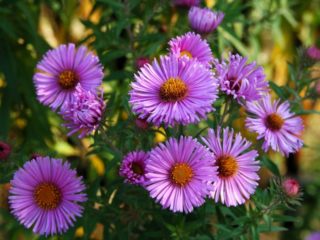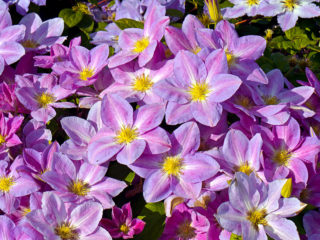Content
When choosing which flowers to plant, many gardeners opt for asters. Bright, luxurious perennials decorate the personal plot. Bouquets of them are readily purchased for various holidays and events. But, unfortunately, asters are susceptible to a number of diseases, they are often attacked by various pests. So that the work on cultivation is not in vain, it is necessary to follow the rules of agricultural technology. It is important to know the diseases of asters and methods of their prevention, to distinguish the alarming symptoms of plant damage by insects in the early stages.
Symptoms of diseases and pests of asters
Asters are quite unpretentious and resistant to negative factors. Their cultivation is available even to novice flower growers. But they can still get sick. Perennial aster diseases are divided into 3 types:
- viral, which are very difficult to treat or incurable;
- bacterial caused by various pathogens;
- fungal, usually resulting from improper care.
A plant can feel depressed as a result of a violation of agricultural technology, and a weakened sprout is a good environment for the development of various infections. Common symptoms of pest and disease damage are:
- slow growth and development;
- the appearance of spots on stems, leaves;
- wilting of foliage and buds;
- plants die despite proper care.
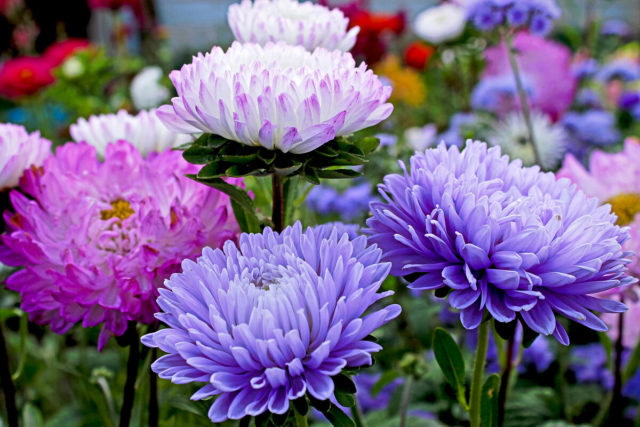
Aster is the soul of the garden, flowering with proper care continues until mid-autumn
Diseases of asters and the fight against them
Free trade in seed and planting material from abroad contributes to the emergence and spread of dangerous diseases that are not typical for the region. The number of viral infections has increased, today there are 24 of them, and most of them are incurable and highly contagious.
Fusarium wilting
The most dangerous fungal disease of asters. The pathogen remains in the soil, penetrates the flower through the roots. As the mycelium grows, it clogs the vascular system. As a rule, this occurs at the beginning of flowering. External signs of the disease:
- slightly yellow and wilted leaves at the first stage, then they turn black, curl and fall off;
- longitudinal spots and stripes of a brownish tint appear on the stems, and the affected area is on one side of the aster;
- flower tissues in the affected areas crack, open, exposing mushroom bloom and pinkish pads.
Aster stops growing, fades. Fusarium is incurable. In the early stages, when the flowers can still be saved, it is impossible to detect it. And when defeat is visible to the naked eye, it gets late. It remains only to urgently remove diseased specimens so that they do not infect all plantings, and abundantly shed this area of soil with a solution of copper sulfate.
Aster disease caused by the fungus Fusarium is shown in the photo.
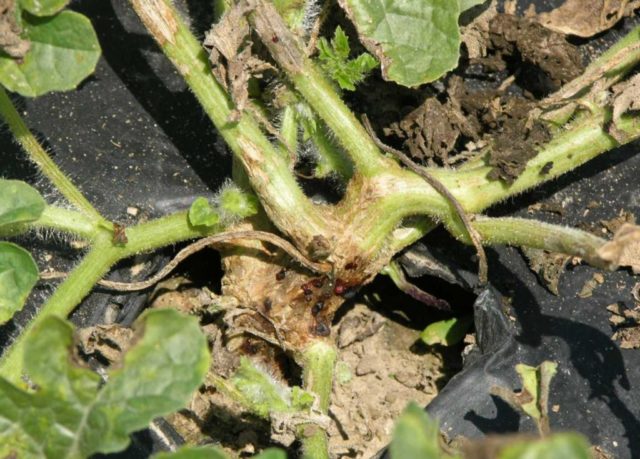
The fungus attacks the root system and rises up the stem
Blackleg
This disease often affects asters. The causative agent is a fungus that lives in acidic soils. Signs of the disease:
- black spots appear on seedlings and seedlings;
- the base of the stem and the root collar decay.
The stems fall to the ground and the flower dies. Treatment is as follows:
- Remove all affected seedlings.
- Spill the remaining flowers with Fitosporin solution.
- In the phase of two true leaves, re-spray with the same preparation.
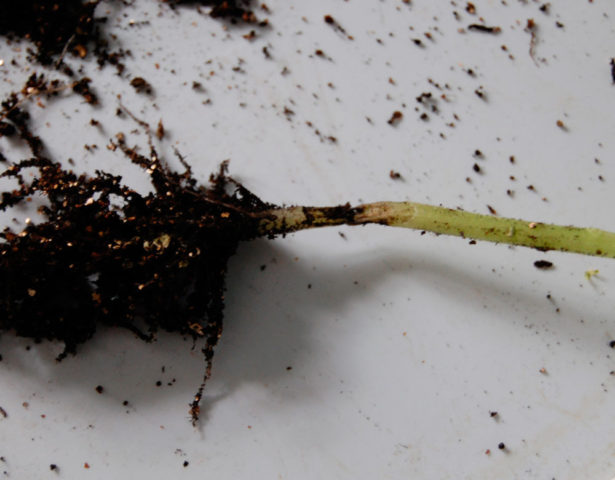
The most effective means of preventing this disease of asters is to disinfect the soil before planting.
Rust
The disease manifests itself in the form of bright red swellings on the inside of the leaves. They contain spores of the pest fungus. If you do not fight with it, the leaves begin to wither, fall off, and the plant dies. Control methods: spraying with a 1% solution of Bordeaux liquid for 10 days. You can also treat asters with sulfur powder in combination with the same amount of hydrated lime.
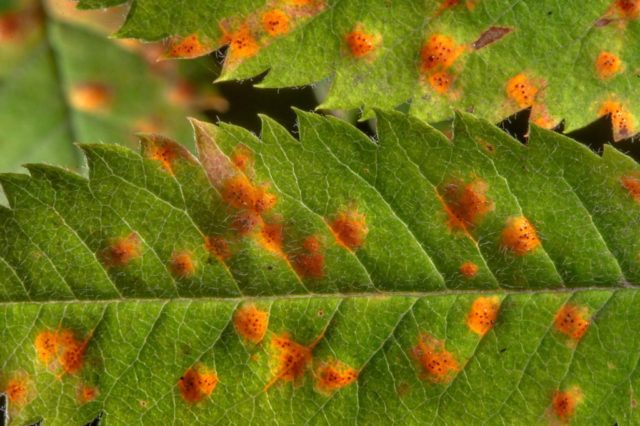
The source of rust infection is pine trees, so planting asters closer than 300 m from these trees is not recommended
Jaundice
Dangerous viral disease of asters. External signs:
- light yellowish spots appear on the leaves along the veins, which eventually turn white;
- the growth and development of the plant stops.
The disease cannot be cured, the affected plants must be burned so that the infection does not spread.
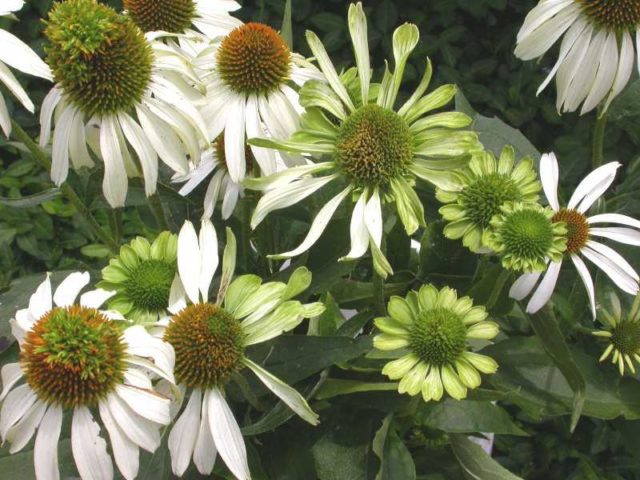
Aster Infection is Carried by Insects - Aphids and Cicadas
Bacterial spot
The causative agent of the disease is Pseudomonas Liquide. Bacteria survive on plant debris, soil, and seeds. Affected asters develop brown oily spots. If you do not take any measures, the leaves curl, the bush dies. At the first sign, it is necessary to treat the plants with copper sulfate, repeating the procedure 2-3 more times within a month.
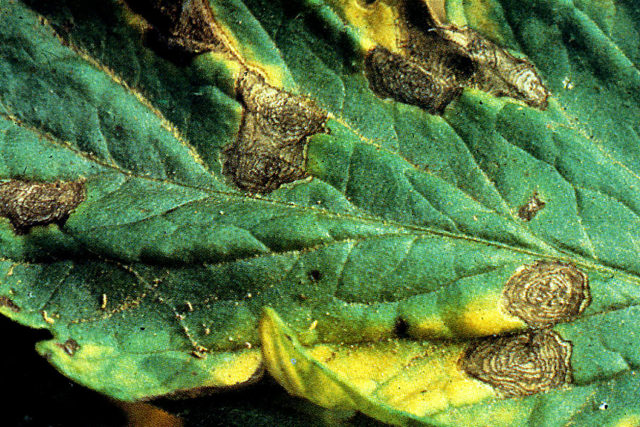
Usually, the first symptoms of a dangerous disease of asters appear in the budding phase.
Gray rot
The disease affects all aerial parts of the plant, they acquire a light brown, beige tint and rot. In the last phase, a gray fluffy bloom appears on these areas. The only treatment is to cut out and burn all the affected parts of the asters.

Young bushes of asters, which did not have time to get stronger, are especially susceptible to disease.
Pests of asters and the fight against them
Asters are the favorite food of various pests. Parasites have a depressing effect on the plant, drinking juices, transferring diseases.
Aphid
Small insects settle on the inner, shaded side of leaves, drinking all the juices from them. The carriers of this infection are ants. Aphids multiply rapidly. That is why it is very important to treat the affected plants with "Karbofos" or any other preparation for these insects as early as possible.
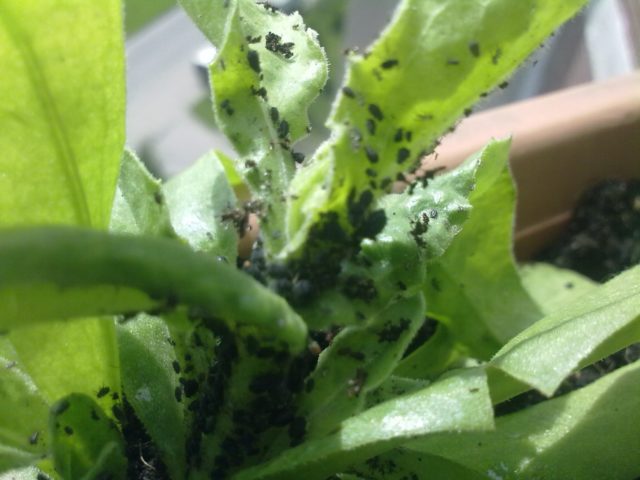
The destruction of anthills on the site is an effective way to combat aphids
Spider mite
The pest settles on the inside of the leaves, braiding them with a barely noticeable cobweb. Greens lose color, curl, wither and then fall off. Control methods - processing with a saturated solution of laundry soap.

The pest multiplies very quickly, capturing the stems, buds and buds of asters
Aster blizzard
The beautiful butterfly is a dangerous pest. She lays eggs on aster leaves. Caterpillars hatch from them, which eat young shoots, buds, seeds. Insects are harvested by hand, treated with insecticides effective against caterpillars, the soil can be spilled with Bazudin or sprinkled with lime.
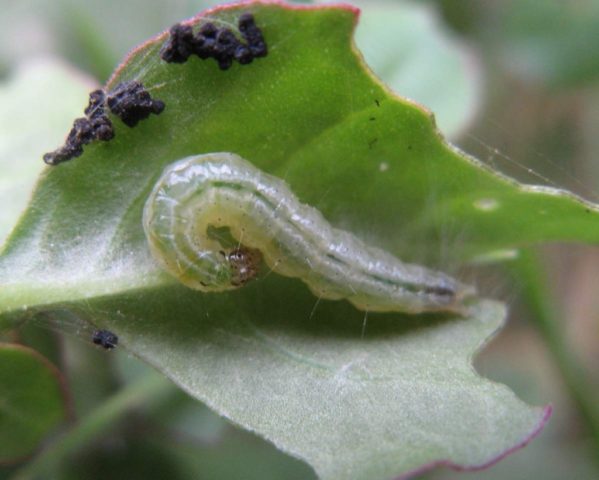
Weeds must be destroyed to reduce the risk of butterflies.
Prevention of diseases and pests in asters
Most of the diseases will bypass asters if you follow certain rules and regularly carry out preventive treatments and examinations. The principles of agricultural technology are quite simple:
- you cannot grow asters in one place for more than 4 years;
- when landing, you must observe the prescribed distance, and choose a sunny place;
- nearby groundwater and flooded areas can provoke the development of diseases in asters;
- fresh manure can cause infection, it is better to use well-rotted humus;
- loosening after watering will give an additional flow of oxygen to the roots of asters, which has a good effect on their development and ability to resist diseases;
- seeds must be soaked in the preparation "Fundazol", a weak solution of manganese;
- the soil should be disinfected before planting - steamed, dug up with lime, spilled with a solution of copper sulfate or copper oxychloride;
- help processing with a pink solution of manganese, tincture of onion peel;
- at the first signs of fungal diseases, plants must be treated with fungicides according to the instructions, scheduled spraying is carried out 2-3 times a season - at the beginning of the growing season, at the stage of budding and at the end of flowering;
- folk remedies help from a number of pests - infusions of tobacco, tomato tops, onions, yarrow;
- it is necessary to observe the irrigation regime, avoiding overdrying and too much moisture, the soil can be disinfected by spraying with copper sulfate once a month, this will save from the development of fungal disease, rot;
- at the initial stage, pests can be dealt with with a simple soapy solution with the addition of caustic substances - pepper, garlic, onions, ammonia;
- once a month, asters can be sprayed with a solution of boric acid;
- regular top dressing in the form of fertilizing the soil and spraying also strengthens asters well, preventing the development of diseases.
If during the growing season infectious diseases were found on the aster bushes, then it is better to transfer the planting to the next year, and thoroughly disinfect the soil with manganese, fungicides, and copper preparations.
Conclusion
Aster diseases are unfortunately common. Infection can persist in soil that has not been thoroughly treated. Viruses, fungi and bacteria can transfer insects from diseased plants. Attacks of various pests are not excluded. Prevention measures will help prevent diseases. Compliance with the requirements of agricultural technology, the destruction of sick and suspicious specimens, the absence of weeds and plant residues in the flower beds - these are the principles of growing healthy, beautiful asters.
